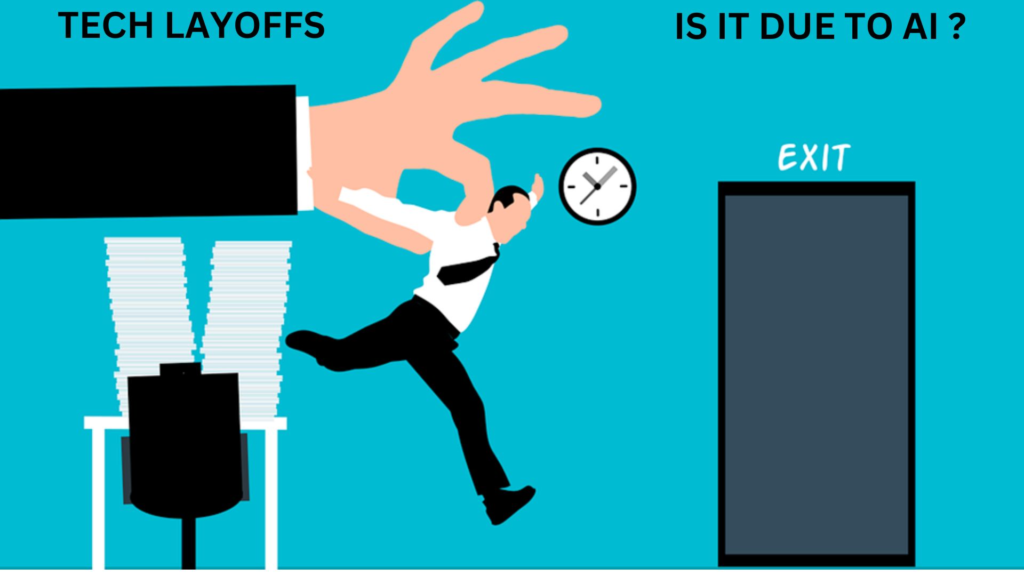
In today’s rapidly evolving technology landscape, the occurrence of tech layoffs has become a common phenomenon. Behind these workforce reductions lie complex dynamics influenced by various factors. In this article, we delve into the truth behind tech layoffs, shedding light on the role of AI, exploring the reasons behind workforce changes, and emphasizing the importance of reskilling and adaptability for a future-ready workforce.
Is AI behind all of these tech layoffs ?

Tech layoffs cannot be attributed solely to AI. It is crucial to examine the broader context within which these decisions are made. Evolving business dynamics, changing market conditions, and strategic restructuring efforts all play a significant role in shaping employment trends. Companies operate in highly competitive environments, requiring them to adapt and realign their workforce to stay agile and competitive. Workforce optimization and cost reduction strategies often drive decisions regarding layoffs.
Clarifying the Role of AI in Employment Trends
While AI has undoubtedly transformed industries, it is important to debunk the misconception that it is solely responsible for tech layoffs. AI serves as a powerful tool that enables efficiency gains, business transformation, and human-AI collaboration. It automates repetitive tasks, enhances decision-making processes, and augments human capabilities. However, it is essential to recognize that AI also creates new opportunities and roles that require human expertise, creativity, and empathy. Rather than displacing jobs, AI often reshapes them, necessitating reskilling and adaptation to leverage emerging opportunities.
What is the exact reason behind the Tech Layoffs if not AI ?
Tech layoffs can stem from a variety of factors beyond AI. Market conditions, such as economic downturns or shifts in consumer behavior, can impact a company’s financial performance and necessitate cost optimization measures. Mergers, acquisitions, and corporate restructuring initiatives often lead to redundancies, requiring workforce realignment for integration and operational efficiency. Technological advancements and automation also contribute to workforce changes as certain job functions become obsolete or can be performed more efficiently by machines. Let’s throw some light on each of them in upcoming section.

Changing Market Conditions
Market conditions play a significant role in shaping a company’s decisions regarding layoffs. Economic downturns, shifts in consumer behavior, or disruptive technologies can impact a company’s financial performance. In such cases, organizations may need to streamline operations, cut costs, or optimize their workforce to ensure sustainability and weather the challenges posed by the market.
Mergers, Acquisitions, and Restructuring
Mergers, acquisitions, and corporate restructuring initiatives can also lead to tech layoffs. When companies combine or undergo significant changes in their organizational structure, duplications or overlaps in roles and responsibilities may arise. Streamlining operations and eliminating redundancies becomes necessary to achieve operational efficiency and integration. While such decisions are undoubtedly difficult, they are often essential for the long-term viability of the newly formed entity.
Technological Advancements and Automation

Advancements in technology and the rise of automation can also contribute to tech layoffs. As companies embrace automation and artificial intelligence to streamline processes and enhance productivity, certain job functions become obsolete or can be performed more efficiently by machines. This shift may result in the displacement of certain roles, requiring companies to reskill or reassign their workforce accordingly.
Financial Pressures and Cost Optimization
Financial pressures, including declining revenues or profitability, can drive companies to resort to layoffs as a means of cost optimization. Workforce reduction is often seen as a short-term measure to align expenses with revenues, stabilize financial performance, and maintain investor confidence. While these decisions are challenging and impact employees, they are sometimes necessary to ensure the company’s survival and protect the jobs of remaining employees.
How tech layoffs can be avoided in the future ?
Navigating the Future: Reskilling and Adaptability
To thrive in a rapidly evolving tech industry, reskilling and adaptability are crucial. Rather than fearing job displacement, individuals and organizations should embrace continuous learning. Upskilling allows employees to remain relevant and seize emerging opportunities. Companies play a vital role in fostering a culture of continuous learning, providing reskilling initiatives, and supporting employees in navigating career transitions. Collaborating with AI, individuals can leverage their unique human skills such as critical thinking, problem-solving, emotional intelligence, and creativity.
Collaboration Between Humans and AI

The future of work lies in collaboration between humans and AI. While some routine tasks may be automated, human skills such as critical thinking, problem-solving, emotional intelligence, and creativity become even more valuable. By leveraging AI as a tool to augment human potential, organizations can create synergistic partnerships, leading to increased productivity, innovation, and job creation.
Embracing Ethical AI Practices
Responsible AI implementation is crucial to mitigate any potential negative impact on employment. Ethical considerations should guide the development and deployment of AI systems, ensuring fairness, transparency, and accountability. Companies must actively address concerns regarding job displacement and proactively seek ways to reskill and redeploy employees in roles that leverage their unique human skills.

What are the key takeaways for us ?
- Tech layoffs are influenced by multiple factors, and AI is just one piece of the puzzle.
- While AI-driven automation and technological advancements can impact job requirements, it’s crucial to consider the broader context of evolving business dynamics, market conditions, and organizational strategies.
- To navigate the changing landscape, we should prioritize reskilling and adaptability.
- Fostering a culture of continuous learning and flexibility is essential to stay relevant in the rapidly evolving tech industry.
- It’s important to promote ethical AI practices to ensure its responsible implementation.
- By embracing these approaches, we can harness the potential of AI while maximizing human potential and creating a future that benefits all stakeholders in the technology sector.
Thank you
I am truly thankful to the owner of this web site who has shared this fantastic piece of writing at at this place.